Five Tribes is an area control, set collection game.
Title: Five Tribes
Year Published: 2014
Designer: Bruno Cathala
Publisher: Days of Wonder
Players: 2-4
Game Time: ~60 Mins
Set-up Time: >10 Mins
Ages: 12+
Theme: Arabian Mythology
Mechanic: Area Control, Set Collection, Bidding
How to win: Score the most points.
Game Description
Crossing into the Land of 1001 Nights, your caravan arrives at the fabled Sultanate of Naqala. The old sultan just died and control of Naqala is up for grabs! The oracles foretold of strangers who would manoeuvre the Five Tribes to gain influence over the legendary city-state. Will you fulfil the prophecy? Invoke the old Djinns and move the Tribes into position at the right time, and the Sultanate may become yours!
Set-Up
I’ll only explain a 3-4 player game here but just keep in mind that set-up and gameplay change slightly for 2 players.
Each player takes 8 camels and 1 turn marker in their colour along with 9 x 5 and 5 x 1 gold, gold is kept a secret… Gold points.
Shuffle the tiles and make a 6 x 5 grid then shuffle all the meeples in a bag and put 3 on each tile. ( I like to lay them all down for reasons I will explain later)
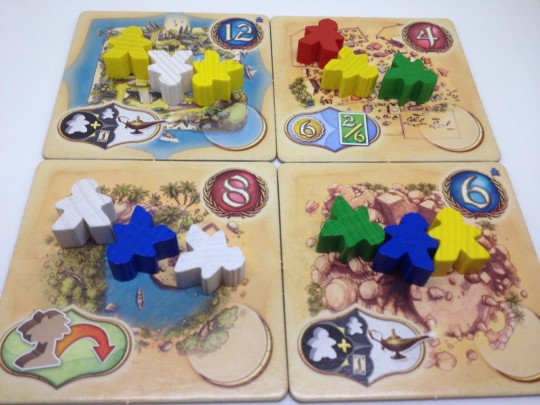
Randomly place the turn markers on the bidding track and shuffle the resource cards, laying 9 out face up in a row next to the draw pile and shuffle the Djinns and lay 3 out face up.
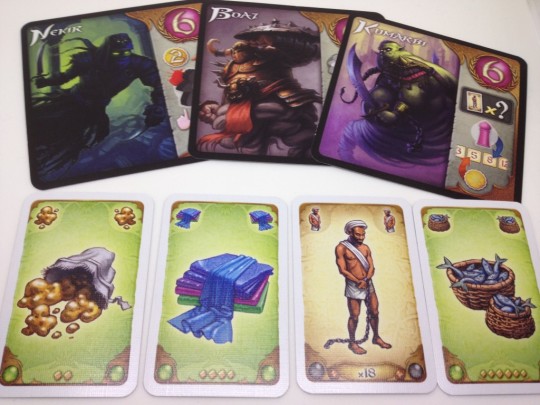
Five Tribes Game Play
Gameplay has a few phases…
Bid for Turn Order
In order on the bidding track, bid for turn order paying the amount in gold and putting your marker on that spot. If you bid 0 and someone else already has, you push players down the track, going ahead of them.
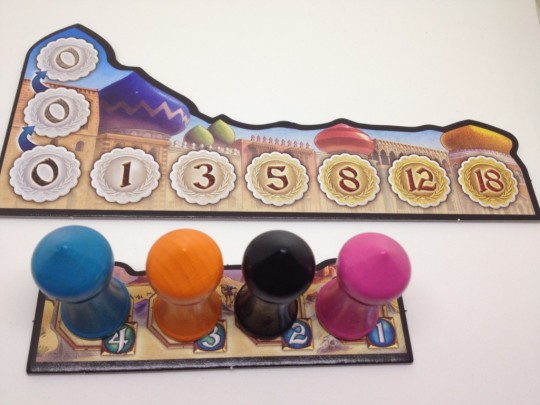
Once everyone has bid, players will take their actions in turn order and each action phase containing 6 parts…
Move Turn Marker – Put your marker in the first spot on the bid order track. If you go first, you’ll bid first next round.
Meeples
Move Meeples – Select a tile that contains some meeples and move them to adjacent tiles. As you move, drop a meeple off on each orthogonally adjacent tile until you run out of meeples.
There are 3 rules for this…
1 – The last meeple you drop off must match a meeple on the tile you finish movement on
2 – No diagonal movement
3 – No immediate backtracking, but you can complete a full loop if you have enough meeples
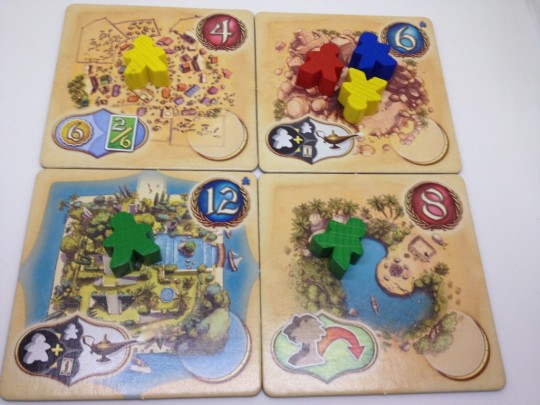
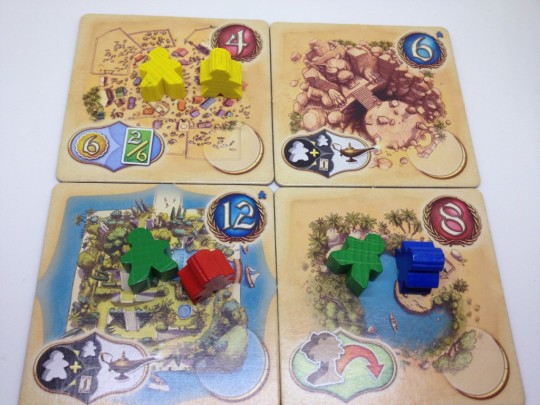
Experience tells me players (especially new players) will make mistakes here so I usually ask they stand up their meeples as they drop them off so they can easily take the turn back. This is why I lay them all down during set-up.
You take the last meeple you dropped off and all matching colour meeples on that tile to your hand.
Tile Control Check – If that tile is now empty, show you control it by placing a camel of your colour on a tile.

Tribe Action
Perform the action of the meeples you picked up.
Yellow Viziers – Kept in front of you, worth end-game VP’s.
White Elders – Kept in front of you, worth end-game VP’s. They can be spent during the game for Djinns. (Explained in a bit)
Green Merchant – Returned to the bag in exchange for resource cards. Take that number of Resource cards from those lined face up, starting at the beginning of the line. (This order is important)
Blue Builder – Returned to the bag in exchange for gold. You count the number of surrounding tiles, including the centre tile and times that number by the total of picked up Blue meeples plus and discarded slave cards you wish to get rid of.
Red Assassin – Returned to the bag, kill 1 meeple on a tile within 1 orthogonally adjacent Tile per Assassin you just dropped in the bag. Alternatively, kill 1 yellow or white meeple in front of another player. If you kill the last meeple on the tile you can put a Camel on it to show you control it.
Tile Action
Perform the action of the tile your last meeple ended on, even if you don’t control it. If the symbol on the tile has a red arrow, the action is compulsory.
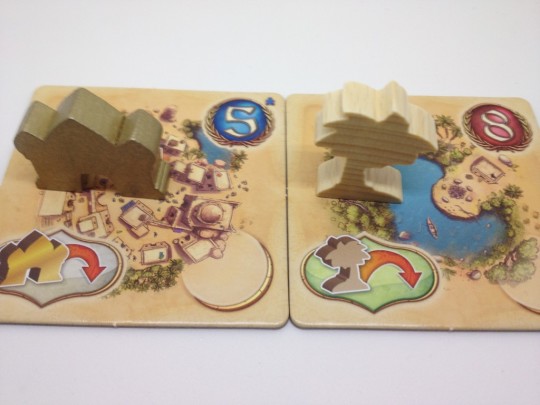
Oasis/Village – Place a Palm Tree/Village, there can be any number of these on the tile. If there are none left in the supply, ignore this action.
Small Market (1/3) – Pay 3 coins to buy 1 resource card from the first 3 visible.
Large Market (2/6) – Pay 6 coins to buy 2 resource cards from the first 6 visible. If only 1 card is left, you still pay 6 but only buy 1 card.
Sacred Places – Pay either 2 Elders OR 1 Elder + 1 Slave to take the Djinn of your choice.
Merchandise Sale (optional) – After taking these actions you can sell non-slave merchandise for points based on a scale.
Each player takes these actions in the order on the bidding track. Once everyone has taken their actions shift resource cards down and draw back up to the available 9, reshuffle the discard pile if needed. Also draw back up to 3 Djinns, again reshuffle the discard pile if needed.
Go back to the ‘Bid for Turn Order’ phase.
Game End
When a player places their last camel, or there are no more legal moves remaining the game ends after the round is fully completed.
Scoring
+1 VP for each Gold Coin
+1 VP for each Yellow Vizier + 10 VP for each opponent who has less than you
+ 2 VP per White Eldar
+VP’s of your Djinns
+VP’s of tiles with your camels on
+3 VP for each Palm tree on a tile you control
+ 5 VP for each Palace on a tile you control
+VP’s for each series of Merchandise (but not Slaves) you own that are all different
Tied winners will have to learn to share their power.
Five Tribes Round-Up
The game has a random board set-up, random meeple set-up and random starting Djinn set-up which means the game is different each time. You can go for the same Meeple strategy that works for you I guess but you’re not guaranteed to get the tile action you need or the Djinn you want while you’re doing it.
It could be said that a Djinn you get can determine how you play the game but they don’t have to. It could also be said that if you had a Djinn at your disposal in real life you would use it to your advantage. 🙂
With scoring being so varied you can take different routes to victory and I’ve seen players win with a pure Tile Control, Merchandise or Djinn strategy so it’s quite well balanced.
Five Tribes Rating
One of the better strategic games available with great replayability.
This game is in my Board Game Hall of Fame
I give it 8/10
Five Tribes Ups & Downs
Check out where it ended up on the Board Game Ups & Downs League Table!
The Artisans of Naqala Review
So downside, Five Tribes has a Six Tribe which is weird. Upside, the Tribe is Purple.
This tribe, the Artisans give you more options when buying stuff.
A chasm and Mountains restrict movement around the board which is fun. Although, the extra tiles now have an extra setup step.
I think this is not a must-buy expansion but you won’t be disappointed if you get it. It’s one you’ll play with.
The Thieves of Naqala Review
This is a tiny expansion. You just get 1 new Djinn and some Thieve cards, one for each colour Tribe.
Instead of buying a Djinn, you can buy the 1 face-up Thief instead. This affects the Tribe of the colour it represents and will cause your opponents to lose something…
So, tiny and cheap, well worth getting. Unless you don’t like the Take That element of it. But it is optional so you can always leave it out in games where you think players won’t like it.
Five Tribes Initial Review September 2014
This is a very simple game with some unique gameplay. They call it a ‘Worker Displacement’ game… get it? The board starts full of meeples and you take turns removing them to take action.
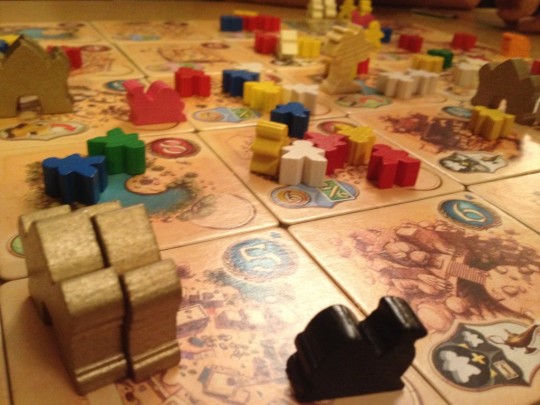
It’s a nice weight. Not too heavy, not too light. Reminds me of Bruges without the randomness. The balance of bidding your money (VPs) for turn order vs taking a turn and earning points is a tough one. You could spend 18 gold to gain 20 points, is that a good idea? Spend 12 gold to gain 10 points but get a Djinn in the process… is that worth it? maybe, it’s up to you.
It looks pretty, with lots of colours and the artwork is great.
I just like the way the game plays. As we were packing it away the first time we were talking about playing it again, and we did shortly after.
The Djinns are great and help you craft your strategy, as well as looking awesome.
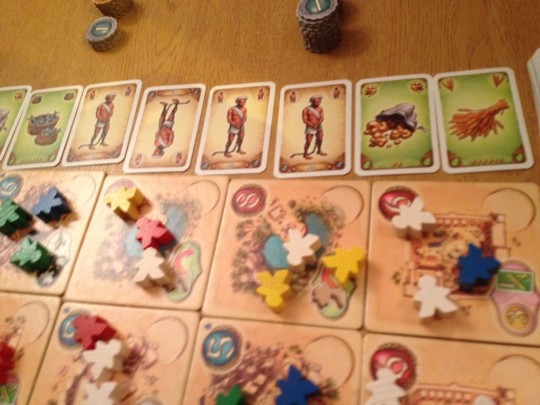
The rest?
Well, it has slave cards and the debate about this is odd. Slavery happened, it wasn’t nice, but it happened and we can’t ignore it. Bruno Cathala and Days of Wonder aren’t condoning it, people, it’s just a card based on something that happened at that time and is mentioned in the One Thousand and One Nights folk tales the game is based on.
You get points for everything and just because it isn’t a Feld game there is no reason why this can’t be called a “Point Salad”?
All in all, this is a very good game I’m looking forward to playing again… and again.
Jesta ThaRogue
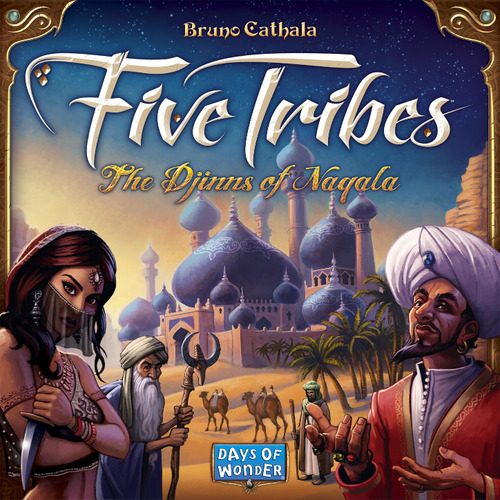

Leave a Reply